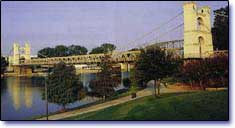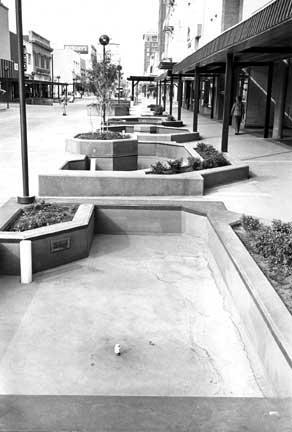

Places in Time

Austin Avenue’s Ill-fated pedestrian mall never caught on
By Terri Jo Ryan, Waco Tribune-Herald
April 24, 2006
One "ghost" of the urban renewal projects of the late 1960s is still evident — barely — on the Waco skyline.
Travel northeast on Austin Avenue, and you can see the remnants of the sign that urged people to "Park & Walk on the Mall" on the exterior of the old Regis building's southwestern side. It is an artifact of a failed experiment 30 years ago to draw shoppers into the downtown establishments so very eager for their business.
The pedestrian mall concept came about in the years after the devastating tornado of May 11, 1953, according to the news accounts of the day. By the late '50s, the Downtown Merchants Association proposed one as a way to lure people back into the traditional commercial district and away from the suburban shopping centers.But until federal urban renewal programs in 1968 gave the city a grant of almost $9 million for downtown demolitions and renovations and a sewer project that would tear up the road anyway, the pedestrian mall stayed on the drawing board.
The construction of the mall cost $850,000, according to the Tribune-Herald. It was to be the central feature in the Brazos Urban Renewal district, which would cover 155 acres from 12th Street to the river, between Washington and Franklin avenues.
The project was awarded to Young Brothers Inc. in December 1969, and the mall was formally dedicated in January 1971. Cars were banned from the area of Fifth to Ninth streets until the Waco City Council voted in February 1979 to reopen the Austin Avenue to vehicle traffic going one-way.
The Downtown Merchants Association at that point said it was all too happy to pay the $5,000 it would take to reinstall traffic lights and crossing signals.
In 1985, when two-way traffic was restored to the area of Third to Ninth streets, it cost more than $750,000 (Young Brothers Inc. won the bid to undo the work they had done 15 years earlier).
Why did the Austin Avenue Mall fail?
According to newspaper accounts of the era, the parking for the mall was supposed to be "available, convenient and free," but those plans were never formulated.
Some officials said the merchants themselves didn't hold enough special events and sidewalk sales to attract people, nor did most give their storefronts and back entrances the face-lifts that would have made them more attractive venues.
Another problem reporters noted was that many merchants closed up too early, so the place was dark after hours. The fountains were used by the homeless to bathe in, and planters were vandalized by youths — further contributing to the seediness factor of downtown.
For
more information, contact: John Young • Waco
Tribune-Herald •